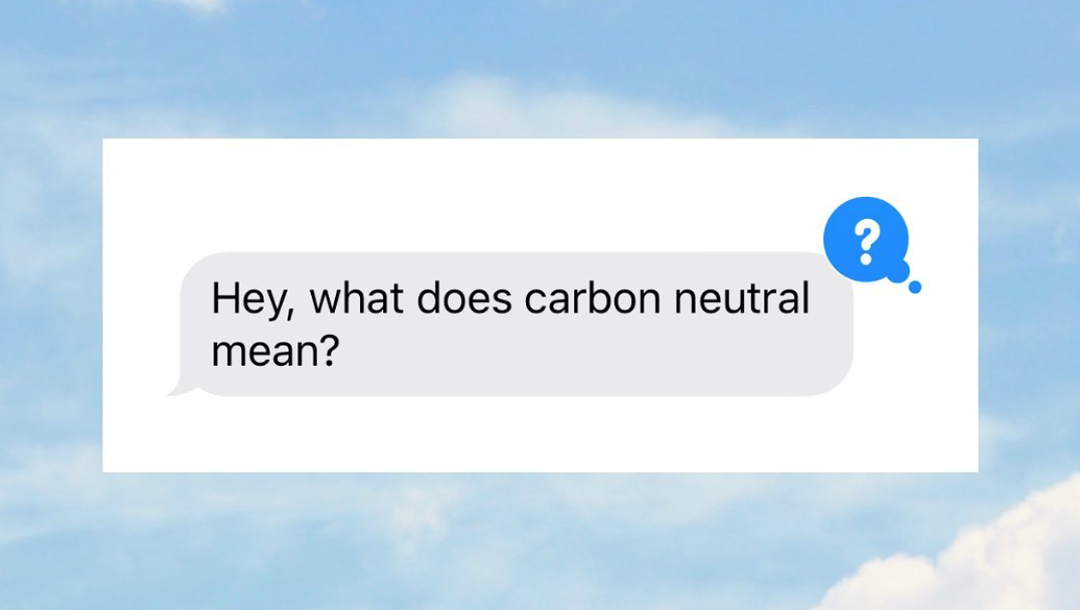What Is Carbon Neutrality?

Written By: John Mascari, COO at Blueland
April 28, 2020
Achieving carbon neutrality is one of the primary goals addressed in the Paris Climate Agreement as one mechanism to help keep global warming at bay, and pathways to carbon neutrality are popular in climate discussions today. So, what is carbon neutrality all about?
The goal of carbon neutrality is to reduce greenhouse gas emissions, and eventually reach zero emissions. To do so, reducing emissions is the first step. For all remaining emissions, for an individual, company or country to reach carbon neutrality, all of the greenhouse gas (GHG) emissions that those entities release as a result of their activities, goods and services have to be offset or balanced out. Offsetting emissions helps to limit and reduce the greenhouse gases that reach the atmosphere and ultimately contribute to global warming. The Paris Climate Agreement, the UN, countries, regions and individual companies and businesses have all set goals by which to achieve carbon neutrality. The global deadline set by the Paris Climate Agreement to reach net-zero emissions is 2050. If these carbon neutrality targets are not met, we run the risk of the climate temperature increasing above 1.5 degrees Celsius from 2010 global temperatures, which could have irreversible consequences for current and future generations.
Usually, emissions released can’t be directly removed from the environment by the individual or company looking to account for their emissions. In order to account for and balance out the greenhouse gasses released into the environment, they purchase carbon offsets. The best way to achieve carbon neutrality is to reduce or eliminate as much as possible. For everything that can’t be eliminated, offsets are purchased. To be carbon neutral, all of the emissions from any activities are added up and offsets are purchased to account for the total amount of emissions, ending with net-zero carbon emissions.
What Are Carbon Emissions?
Carbon emissions are the sum total of all greenhouse gasses (including, but not limited to CO2) that are released as the result of a good, service or activity. This includes emissions of carbon dioxide gas, methane gas, nitrous oxide gas and other harmful greenhouse gasses like Chlorofluorocarbons (CFCs) and Hydrofluorocarbons (HCFCs). Greenhouse gasses are harmful because they contribute to global warming. When they are released they trap heat in the atmosphere. Carbon capture or carbon saving activities help take the emissions out of the air before they contribute to further climate warming. To be carbon neutral, the amount of greenhouse gas emitted needs to be offset completely by saving or removing the equivalent amount of carbon, which means that emissions have to be quantified in detail.
To simplify the process of quantifying greenhouse gas emissions, all emissions are expressed with one standard measurement: Carbon Dioxide Equivalent (CO2e). The CO2e is the global warming potential of each gas relative to carbon dioxide, multiplied by the amount of the gas emitted. The global warming potential (GWP) of a gas is a global measure of how much heat one tonne of each individual greenhouse gas traps in the atmosphere, relative to the amount of heat carbon dioxide traps in the atmosphere. GWP is expressed over a fixed period of time, typically 100 years. For example, methane has a GWP between 28 and 36. That means that one metric tonne of methane traps 28-36 times more heat in the atmosphere than one metric tonne of CO2.
Below are GWPs reported by the EPA for carbon dioxide, methane and nitrous oxide over a 100 year period:

This means that other greenhouse gasses like methane and nitrous oxide have greater global warming potential than carbon dioxide. All emissions from greenhouse gasses have to be added together to understand the total amount of carbon emissions that need to be offset.
What Are Carbon Emissions From Buying A Hamburger?
For example, let’s look at some of the carbon emissions released as a result of buying a hamburger. According to Business Insider, the production of one quarter pound of beef releases about 4 pounds of carbon emissions. These emissions are generated from producing the cattle feed, methane is released from the cows themselves, emissions generated from the butchering process, and from the transport of ground beef to a store or restaurant. In addition, the emissions that an individual releases in the process of purchasing the hamburger, from driving to a store or restaurant, would be added to the 4 pounds of emissions. In order to balance out those four pounds of carbon emissions associated with purchasing a hamburger, an individual would have to purchase carbon offsets. Purchasing carbon offsets is the primary way to offset individual and company emissions. Alternatively, an individual could plant trees to offset their emissions.
What Are Carbon Offsets?
Carbon offsets are used to “offset” carbon emissions from an individual or an entity when emissions can’t be eliminated or reduced any further. Carbon offsets, also called carbon credits, are a way to balance carbon emissions by funding projects that organize carbon capture and carbon storage activities or technologies. There are many different types of carbon offsets for purchase, but most carbon offset programs can be described in at least one of three categories: conservation and restoration, carbon capture and storage technology and social good.
Conservation And Restoration Carbon Offset Projects
Some offset projects help fund conservation and restoration of natural ecosystems. These are activities like reforestation, promoting sustainable forest management and farming practices and preventing ecosystem destruction so that healthy forests and grasslands can be utilized to naturally capture and sequester carbon dioxide. Conservation and restoration programs help rebuild, grow or maintain biodiversity in an ecosystem and help fund natural solutions that help remove carbon from the environment. Plants, grass and trees naturally take carbon dioxide out of the air through photosynthesis, while biodiversity keeps the ecosystem healthy. Reforestation and conservation of plants and trees is critical to maintaining a healthy global environment.
Carbon Capture And Storage Technology Projects
Offsets programs that invest in technology can fund a number of different technical solutions aimed at renewable energy solutions (such as wind and solar) or GHG capture and sequestration. Landfill gas-to-energy programs are an example of carbon sequestration technology. These programs capture methane gas from landfills and turn it into energy. This keeps the methane out of the environment and creates energy without fossil fuels. Investments in technology to reduce emissions from high emitting services might include funding for wind or solar farms that replace energy from fossil fuels energy (which has high carbon emissions) with renewable energy which has far fewer emissions.
Social Good Carbon Offset Projects
Some offsets programs invest in projects that help underdeveloped countries and underserved communities. Underdeveloped countries and underserved communities are disproportionately affected by climate change. For example, these communities might experience a greater impact from pollution or could be less equipped for climate resilience. Climate justice efforts work specifically to help these communities and some carbon offset programs are part of those initiatives. These offsets typically fund technology or initiatives that will help a community and the environment. An example of an offset that provides social good is providing access to safe and sustainable cookstoves in areas where they aren’t available. This helps limit the emissions from fuel sources like coal.
These are just some examples of carbon offset programs. They provide a way for individuals and businesses to help balance out the emissions they release by helping limit or save emissions somewhere else.
How To Become Carbon Neutral
Now that you have all of the terminology, what steps are actually taken to become carbon neutral? The first step to becoming carbon neutral is to do a system-wide emissions audit. For an individual, that means looking at all of your daily activities and daily products, and figuring out how much CO2e is emitted as a result of your activities, goods and services. At the company level, that means looking at all of the products produced and all of the emissions associated with producing that product or providing a service, delivering that product to a store or directly to the consumer, as well as quantifying the emissions associated with day-to-day business operations. For a company that makes a physical product, their carbon emissions could include transporting raw materials to a manufacturing facility, manufacturing itself, shipping finished goods from production facilities to warehouses, preparing goods for the consumer and shipping the products to consumers and stores. In addition, all activities associated with running an office have to be quantified, like energy use in the office and team member commutes from home to work.
Quantifying Carbon Emissions
Quantifying carbon emissions is an incredibly detailed and involved process and can never be done with absolute certainty. Understanding emissions from all parts of a business from the supply chain to shipping products is a complex process, especially for large companies that have more products and processes to account for in an audit.
Once total emissions are quantified, the best next step is to see if there are ways to limit emissions as much as possible. In today’s world, it’s typically not feasible for an individual or company to cut emissions to zero, so a bridge strategy is to first optimize for the lowest possible emissions, and then offset the remaining emissions through the purchase of carbon offsets and give back to the environment.
Carbon Neutrality Key Terms
- Carbon Emissions: Carbon emissions are the sum total of all greenhouse gasses (including, but not limited to CO2) that are released as a result of a good, activity or service. Carbon emissions are expressed in terms of the carbon dioxide equivalent of all greenhouse gasses.
- Carbon Dioxide equivalent (CO2e): CO2e is the standardized measurement used to quantify greenhouse gas emissions. The CO2e is the global warming potential of each gas relative to carbon dioxide, multiplied by the amount of the gas that is emitted.
- Global Warming Potential: Global warming potential is the measure of how much heat one ton of each individual greenhouse gas traps in the atmosphere, relative to CO2, which has a GWP of 1. GWP is expressed within a fixed timeframe, which is typically 100 years. For example, methane gas has a GWP between 28-36. Which means one ton of methane traps 28-36 times more heat in the atmosphere than one metric tonne of CO2.
Keep Reading
Refill is the New Recycle
The perfect way to start cutting out single use plastic from your home.











